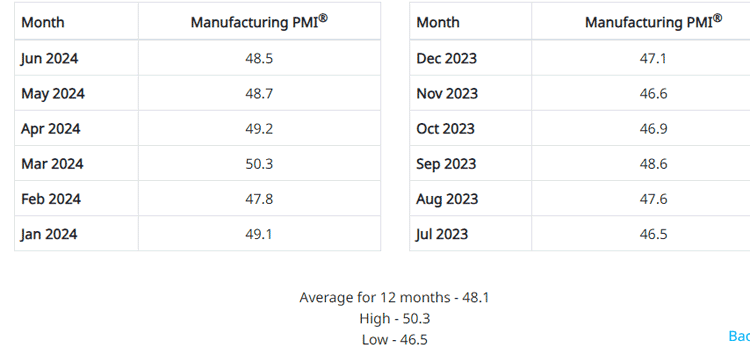The US Purchasing Managers Index (PMI) for June was released Monday by the Institute for Supply Management (ISM), and came at a level of 48.5, again below the key 50 mark that separates US manufacturing expansion from contraction.
The US PMI had previously been in contraction territory for 16 straight months until it poked its head into expansion in March, but has fallen back to contraction in each of the last three months.
The overall economy continued in expansion for the 50th month after one month of contraction in April 2020. The PMI tracks closely but not exactly with the overall US economy.
A Manufacturing PMI above 42.5, over a period of time, generally indicates an expansion of the overall economy, according to ISM.
The other PMI numbers we track were also mostly negative.
That starts with the New Order Index, which remained in contraction territory, registering a score of 49.3, although that was 3.9 percentage points higher than the 45.4 seen in May.
The June score of the Production Index was 48.5, 1.7 percentage points lower than May’s figure of 50.2 percent, as manufacturing output once again moved into contraction status.
The Price Index registered 52.1, down a big 4.9 percentage points compared to the reading of 57.0 in May. That means companies saw a rise in the cost of components, materials and other inputs (below 50 = falling prices), but not as strongly as the previous month.
The Backlog of Orders Index was at a low level of 41.7, down 0.7 percentage point compared to the 42.4 percent recorded in May. That means the order book of most companies is shrinking, with the index level still well below the 50 mark.
The Supplier Deliveries Index remained in “faster” territory, at 49.8, which was 0.9 percentage point higher than the 48.9 seen in May, and also under the 50 mark.
Supplier Deliveries is the only ISM index that is inversed, with a reading of above 50 indicating slower deliveries, which is typical as the economy improves and customer demand increases - or the reverse.
The Inventories Index came in at a score of 45.4, down 2.5 percentage points compared to May’s level of 47.9, with the score below 50 indicating inventory levels at companies are again decreasing.
Said Timothy Fiore, Chair of the Institute for Supply Management Manufacturing Business Survey Committee: “US manufacturing activity continued in contraction at the close of the second quarter. Demand was weak again, output declined, and inputs stayed accommodative.”
He added: “Demand remains subdued, as companies demonstrate an unwillingness to invest in capital and inventory due to current monetary policy and other conditions. Production execution was down compared to the previous month, likely causing revenue declines, putting pressure on profitability. Suppliers continue to have capacity, with lead times improving and shortages not as severe,” in comments repeated from last month.
(See More Below)
|
CATEGORY SPONSOR: SOFTEON |
|
|
| |
| |
|
|
As always, the ISM report provides a graphic of the full PMI scores the last 12 months, which as can be seen indicates the measure has below the key 50 for the past year and actually since November 2022, with the exception of March 2024. It is now averaging just 48.1 over the past year.
US PMI Last 12 Months

Source: ISM
Of the 18 sectors tracked by ISM, eight manufacturing industries reported growth in June. They are, in order: Printing & Related Support Activities; Petroleum & Coal Products; Primary Metals; Furniture & Related Products; Paper Products; Chemical Products; Miscellaneous Manufacturing; and Nonmetallic Mineral Products.
As always, there were some interesting comments from PMI survey respondents.
“Customers continue to cut orders with short notice, causing a ripple effect throughout lower-tier suppliers,” said one manager in the transportation equipment sector.
“Customers ordering more to create buffer stocks (in case of) future shortages,” added a respondent in the eElectrical equipment, appliances & components industry.
Finally, a manager in the fabricated metal products sector noted that “Order levels in two of our main divisions are indicating weak demand, and now we must work to reduce inventory levels.”
Any reaction to June PMI? Let us know your thoughts at the Feedback section below.
|